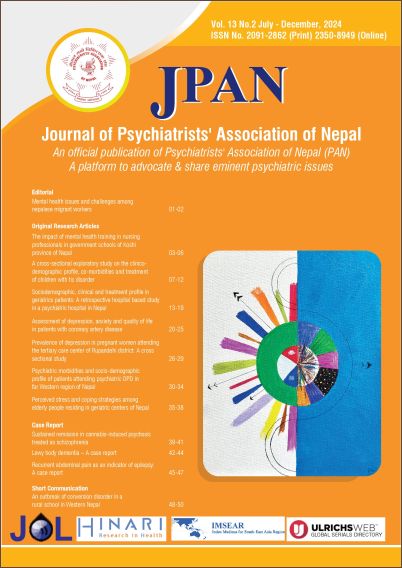Assessment of depression, anxiety and quality of life in patients with coronary artery disease
DOI:
https://doi.org/10.3126/jpan.v13i2.74912Keywords:
Anxiety, Coronary artery disease, depression, Quality of life, WHOQOL-BREFAbstract
Introduction: Coronary artery disease (CAD) is the most common type of cardiovascular disease. Depression and anxiety are common in people with CAD and are associated with worse cardiac outcomes and quality of life.
Objectives: To estimate the prevalence of anxiety and depression, and to find the effect of anxiety and depression on the quality of life in patients with CAD visiting cardiology outpatient at Manmohan Cardiothoracic Vascular and Transplant Center, Tribhuvan University from November 2019 to October 2020.
Materials and Methods: The study was a cross-sectional design comprising a total sample size of 96. Socio-demographic and clinical profiles were obtained using a semi-structured proforma. A validated Nepali version of the Hospital Anxiety and Depression Scale (HADS) was used to assess anxiety and depression. ICD-10 DCR was further used to categorize anxiety and depressive disorders. Quality of life was assessed using WHOQOL-BREF.
Results: The majority of the participants were of the age group 40-64 years (61.5%) were male (70%) and had a diagnosis of ST elevation myocardial infarction (STEMI) (57.3%). Anxiety disorder was present in 27.1% and depressive disorder in 20.9% of patients with CAD. The WHO-QOL-BREF scores were significantly negatively correlated with the HADS A score across domain one (p<0.05) and domain two (p<0.05) and also negatively correlated with the HADS D score across all four domains(p<0.05).
Conclusion: A significant proportion of patients with coronary artery disease suffer from anxiety and depression. The presence of comorbid anxiety and depression significantly affects their quality of life.
Downloads
Downloads
Published
How to Cite
Issue
Section
License
Copyright (c) 2024 Journal of Psychiatrists' Association of Nepal

This work is licensed under a Creative Commons Attribution 4.0 International License.
This license enables reusers to distribute, remix, adapt, and build upon the material in any medium or format, so long as attribution is given to the creator. The license allows for commercial use.




